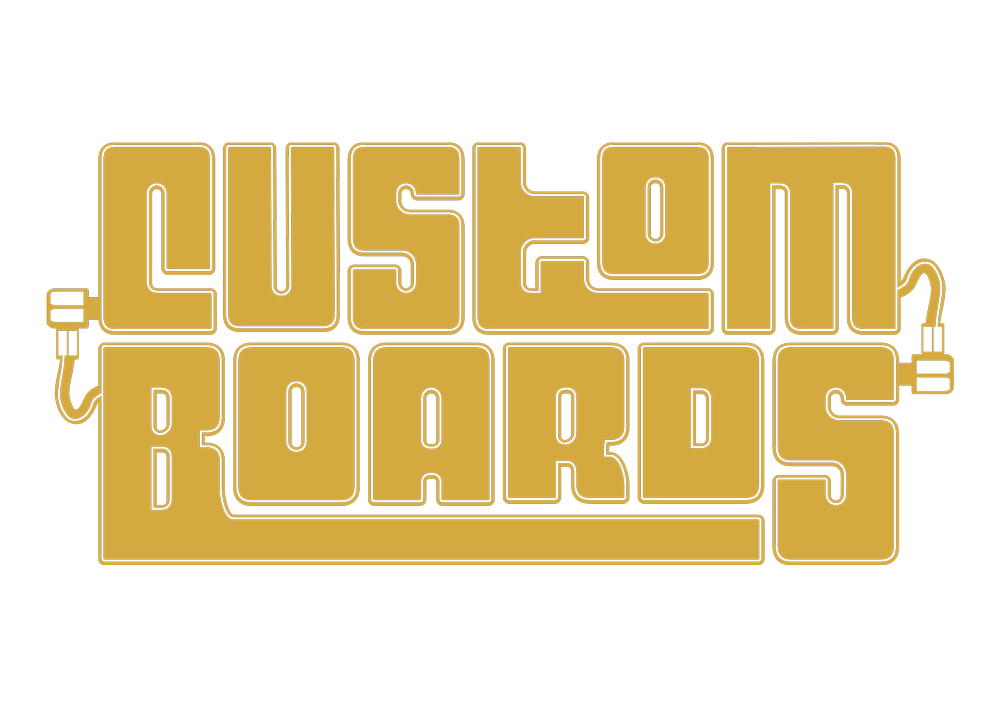A mythical fame of a Dumble Amplifier
May 14, 2014
THERE MUST BE MORE than 2,000 different overdrive pedals on this planet, and very often I feel like I’ve seen it all. Even as you read this, I’m sure, somebody, somewhere is just putting the finishing touches on a “new” overdrive pedal, which promises all of the same things like every other overdrive: A transparent, warm and organic tone, which reacts faithfully to your guitar’s volume control and your playing dynamics. Everybody is bandying about the same old, tired phrases. If I see just one more half-assed copy of a vintage Ibanez Tube Screamer, my belief in the pedal designers will be shattered for good.

There’s only one overdrive pedal that would manage to arouse my interest. If somebody promised to make me an overdrive pedal that manages to pack all the tonal goodness of a Dumble Amplifier into one little box, I’d be more than willing to give it a listen.
There’s a general consensus among guitarists that the overdrive circuit found inside a Dumble Amplifier is the best anyone’s ever heard. No wonder, as we’re talking about the world’s most expensive guitar amp. The man behind this exquisite amp is Alexander Dumble. Used Dumbles go for as much as US$ 110,000. Dumble’s total production numbers amount to less than 300 amps, with the last examples produced in the second half of the Nineties.
For many, these amps represent the ultimate in guitar tone. Famous Dumble-users include Stevie Ray Vaughan, Robben Ford, Eric Johnson, Ry Cooder and Carlos Santana. Yours truly was so fascinated by this rare amp that I even took on a job as Santana’s stage hand at one gig – just to see and hear the famous Dumble magic from up close.

Now, this very same, harmonically rich, creamy and singing overdrive sound has been distilled into a humble pedal effect, with a price tag that’s only a tiny percentage of the amount you’d have to dish out for a genuine Dumble amp. There have been a few earlier attempts at this from different makers, none of which got it right completely. This time the pedal has been designed by a Finn, and it´s manufacturer comes also from Finland.
Lassi Ukkonen is known as an local amp guru. He joined forces for this project with Finnish amp and effects company Mad Professor, claiming to have finally achieved what many had only dreamt about – packing the planet’s most-wanted guitar tone into a compact stomp box. The pedal is called Simble, and it sure looks great, but will it really cut the tonal mustard?

According to Lassi, the Simble’s overdrive tone takes the guitar’s own sound as its most important foundation, this overdrive isn’t just something that’s plastered on top. Regardless of the pedal’s control settings, your pickups still retain their character, keeping your original tone intact. If you know how to use it, the tone will follow your playing faithfully. The Simble is brimful with the same organic texture that has made the original amp so special, says Lassi, because the circuitry of this stomp box closely follows Dumble’s original principles.
And, guess what? This pedal delivers big time! The Simble truly walks the walk – it’s extremely transparent, senses playing dynamics like a dream, and sounds warm and organic.
This may well be a historic moment, with an overdrive that might, in time, reach the same kind of classic status, of such pedals as the Ibanez Tube Screamer or the Klon Centaur. Trying the Simble will make you rethink your views on overdrive effects.
But why is it that Lassi succeeded at what many other designers around the world have tried, but ultimately failed, to achieve for so long? Firstly, he has several decades worth of experience in this field, great ears and a creative mind. Secondly, he received a lot of inspiration from one of Finland’s best-known guitarists, Peter Lerche.
If you want an amp, you’ll have to send me a record first
One of the things that helped elevate Alexander Dumble to a near-mythical status, was his insistence on getting to know each client’s own playing style. He wanted to listen to a prospective client’s music first, before deciding whether this guitarists would get an amp made or not.
Peter Lerche, whose long and illustrious career includes stintswith UMO and Pekka Pohjola (among many others), wanted to get the world’s best amplifier, too.
Peter had grown to dislike his Mesa/Boogie’s overdriven sounds, as they tended to negate many nuances and details between different instruments. After reading about Dumble amps, he got quite excited at the prospect of the promised increase in dynamic range and texture. Peter wrote a letter to Alexander Dumble, and included a copy of Pekka Pohjola’s record Everyman. Peter suggested that Dumble listen to the track “Blues for Verneri”:
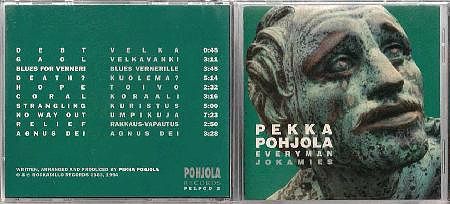
He gave the package to a friend, who was on his way to the NAMM Show. A friend managed to give the letter and the record to Alexander Dumble. Peter was over the moon, when he received a reply only a few weeks later. The reply included a contract, as well as instructions on how to pay the advance for his Overdrive Special amp.
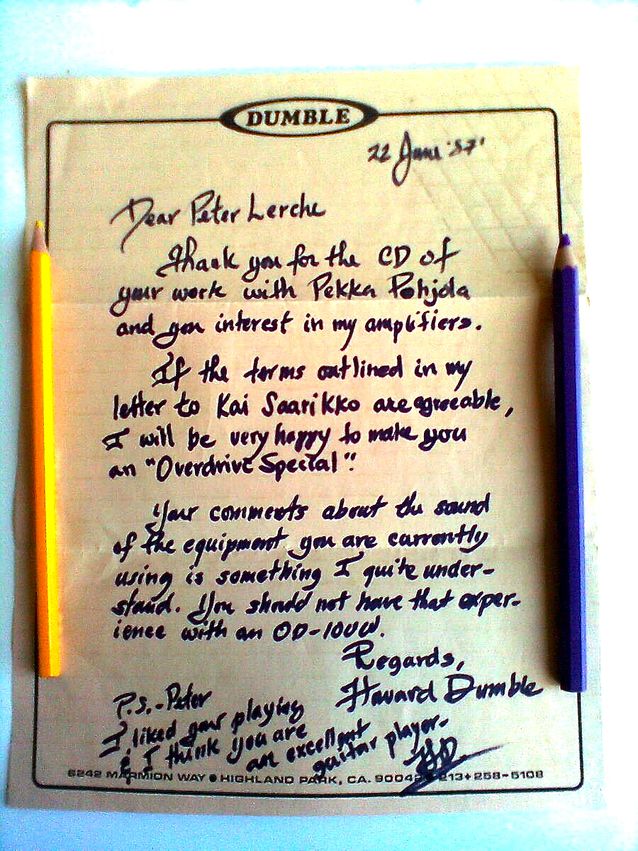
If Dumble’s normal delivery time of 24–36 months was OK by you, the amplifier cost a little over US$ 2,000, which, in 1987, was approximately 50 percent more expensive than Mesa/Boogie’s top-of-the-line model. If you wanted to receive your Dumble as an express order in six weeks, you’d have had to put a whopping 5,000 bucks on the table. Some of the clauses of the contract stipulated that:
- You were not to disclose any of your discussions with the maker.
- You weren’t allowed to open the amp’s chassis.
- You were obliged to not leave the amp anywhere it could be stolen.
- You weren’t allowed to sell the amp.
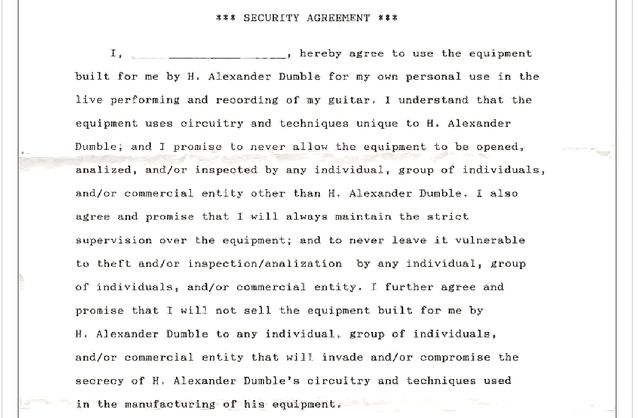
Dumble’s pricelist was also legendary. Here are some examples from 1992:
- Phone consultation (less than 10 minutes): $ 200. For each additional minute: $ 15
- Hourly rate (repairs, modifications, etc.): $ 235
- One full day of work doing amp repairs/mods: $ 1,250
Lerche paid for his amp, and started his long, long wait. Then, after almost giving up any hope, he got word on a crisp November morning – his amp had arrived in Finland! The first Dumble to ever reach our shores…
Power supply woes
To Peter’s chagrin his amp was delivered with a transformer meant for use in the USA (at 110 Volts). This meant he had to have the transformer exchanged for a suitable model for Finland, if he wanted to use his new baby without the need for a clumsy external step down transformer. There was only one man Peter Lerche would trust with this job, and his name was Lassi Ukkonen.
Even to a seasoned pro like Lassi, the utmost attention to detail displayed by the Dumble was something else. He rang back Peter, totally in awe of the amp’s quality and design:
“This guy knows what he does!”
Who was the man behind all this? Who had the cheek to demand complete secrecy, an advance of 10,000 Finnish Markkas, and who would still expect his clients to wait patiently for up to five years?
First of all, Alexander Dumble wasn’t his real name. He was also a completely different kind of persona in the 1960s, when he was still known as Howard Dumble. Along with Mesa/Boogie’s Randall Smith – and a few other specialists – he was one of the first hot-rodders of Fender amps. The goal was to get more gain and overdrive out of the amps, at a time, when these terms were still new.
The birth of singing preamp saturation
Howard based his first designs on the Fender Showman, gathering as much information as he could get, along with some insider knowledge he got from his business partner Jack Smith, who had previously worked at Fender. Both of them didn’t like the preamp overdrive tone of a Mesa/Boogie. Howard was very keen to find his own sound, taking each little detail into account. He wanted to achieve a very even gain structure, to increase the signal level and take it to the next stage in an orderly fashion. In Howard’s view most other amps were functioning far too much in a seat-of-the-pants manner.
No mass production
Dumble was an extremely skilled designer, who disliked mass production. He felt that each amplifier was unique, and he wanted to fine-tune each of his amps carefully, until he was completely satisfied with it. Dumble never set out to produce his amps in large numbers, nor did he have the necessary production facility for large-scale production. His approach was to measure every single component’s electrical value, and only to allow the smallest tolerances, before using it for a Dumble amplifier. According to interviews, his rejection rate for bought-in components stood at 30 percent.

At the same time Randall Smith’s Mesa/Boogie amps became increasingly successful. Howard watched this with interest, but still felt he wouldn’t be able to keep up his high quality standards, were he to produce his amps in greater numbers. There were investors knocking at his door, but their money simply couldn’t entice Dumble to lower his standards.
Despite the offers and his fame, Howard was still determined to keep the reins firmly in his own hands. He felt that Mesa/Boogie were letting slip their quality control. Dumble repeatedly pointed out faults, bad solder joints and plain design errors he found in Boogies. Nevertheless, Mesa/Boogie managed to keep up their “boutique builder” image by clever marketing. Dumble, on the other hand, was destined to stay a one-man operation, enabling him to keep a close eye on the quality of his amps. His amps’ scarcity left the door open for a number of Dumble-clones, one of which is build by Bluetone in Finland:
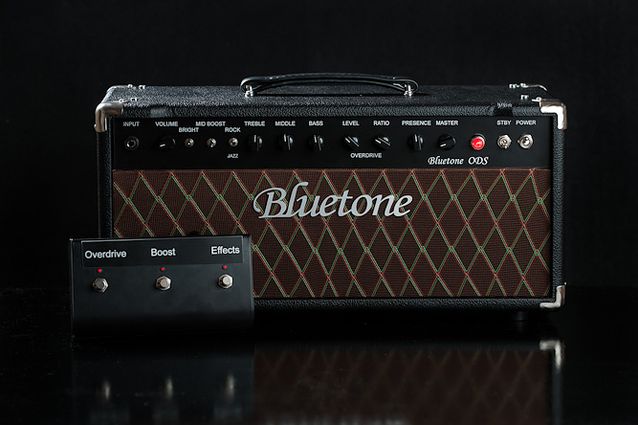
Howard turns into Alexander
The Eighties were Dumble’s decade. He was known as a perfectionist among amp gurus, managing to attract several big names as customers, which cemented his high reputation in the Californian music scene. Shy Howard started to gain confidence, thanks to his success. He changed his name to Alexander, and turned into an artist, who only wanted to work for people he considered worthy of his art. He chose his clients very carefully, and even though KISS, for example, tried to buy some of his amps, he never called them back.

The urge to control keeps on growing
It became increasingly difficult to do business with Alexander. He started viewing customers (and other people) as unwanted distraction that made it difficult for him to concentrate. Slowly, he was turning into a recluse, in order to be able to focus all his attention on his amps, and to control all their functions in peace and quiet. It became increasingly difficult for him to let go of completed amps, and he spent ever more time on fine-tuning and tweaking every miniscule detail. He had been covering the innards of his amps under a thick coat of epoxy for some time, but now his drive to control his Overdrives became an obsession. His amps were all he had, and he treated them like his own children.
By the end of the Nineties, Dumble-production was down to a mere two amps per year. There is little or no news about his whereabout in recent years.
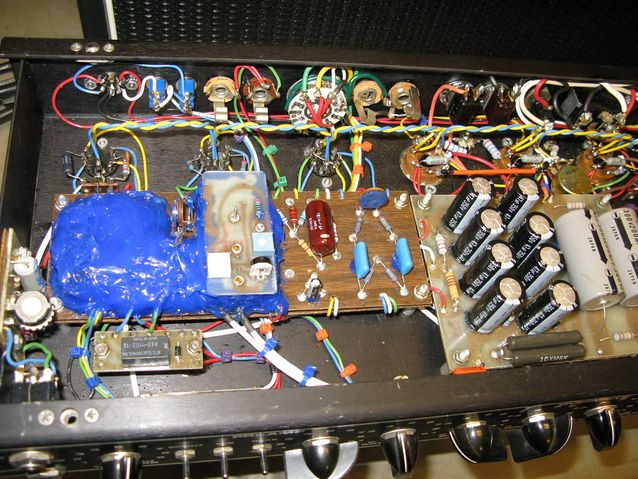
What is the special Dumble-sound?
-
Alexander Dumble: "My amps are best approached slowly. The guitarist should explore the amp’s features by playing. The basis for my designs is to keep the initial gain stage completely clean, not adding overdrive until the second preamp stage. In my view, most other manufacturers drive their first gain stage too hard, clogging up the sound, which results in a very unmusical overdrive sound. You have to harmonize and control the signal levels at each stage of amplification to get the best type of sustain."
-
Lassi Ukkonen: “The Dumble is a very clearly articulating amplifier. A guitarist’s touch and personal style shines through unmasked, which gives you the means to put your own playing across unhindered. The amp’s clean channel is designed for giving you the best sound possible, with no compromises. The overdrive-circuit is a natural extension of the clean channel’s tonal esthetics, there’s no jump from the clean sound to something with different tonal characteristics, like in most other amps. A Mesa/Boogie’s overdriven sound has a strong focus on both extremes of the tonal spectrum, while the Dumble has a completely different approach. Here, everything starts with the guitar’s mid-range.”
- Peter Lerche: “We are talking about an extremely musically-designed amp. Compared to other designs, the Dumble is more of an instrument in itself. I think an amp designer should first sort out his clean tone. If the clean channel sounds great, you can then take this signal onwards into the overdrive-circuit.”
The idea for a stomp box pops up…
A whole decade passed by, and Peter Lerche got the inspiration to record a demo clip with his Dumble, which one of his guitar students put onto YouTube. Peter and Lassi looked on in amazement, as the video started to clock up a lot of views. Lassi started to pursue his dream of distilling the Dumble-sound into a pedal effect, and one day he rang Peter:
“I’ve accomplished it! I’ve solved the riddle! Now I understand what this is all about, and why so many have gotten close, but never made it to the finishing line!”
…is put into practice…
Peter received the first prototype for testing, and instantly fell in love with the stomp box. In his view, he could get all the sounds from this overdrive pedal that he also loved in the amp. No question, Peter wanted one of these pedals, just as did Peter’s bandmate, and this bandmate’s guitar-playing buddy...
Word of the Simble overdrive spread like wildfire. Lassi was inundated with orders, both from local guitarists, as well as from abroad. When I talked to him in June 2013, he said that he had a backlog of around 50 orders. Peter suggested that Lassi could have the pedal built under license. Lassi thought this was a good idea, but he was far too busy to take any concrete steps in this matter.
…and comes into full bloom.
Marko Karhu, who plays on most of Mad Professor’s sound clips and demo videos, was one of Peter Lerche’s guitar students. So it was only natural to explore the possibillity of Lassi joining forces with Mad Professor’s main man Harri Koski. They arranged a meeting at Mad Professor’s headquarters in Turenki, Finland.
“When we arrived at Harri’s office, he had Steely Dan’s record playing on the stereo, which happened to be very same LP I ever bought. I took this as a sign that we would come to an amicable agreement”, Lassi adds with grin.
The wheels started turning, and fast. After agreeing on the terms of his co-operation with Lassi, Harri Koski set Mad Professor’s production line in motion to get the stomp box on the market. And now, six months later, the beautifully packaged Mad Professor Simble has arrived at our shop.
Lassi Ukkonen’s Simble-tips:
- The Simble’s core idea is that the guitarist starts off with the most natural-sounding tonal palette he (or she) can get from both guitar and amp. You should first set the pedal so that the clean tone stays completely unaffected, even with the effect on.
- To make the most of the Simble, you should use a Dumble-style EQ-setting, which differs from your usual Fender-style EQ (especially in the mid-range). If you use a Fender Blackface/Silverface amp, try to get the most natural sound by using these tips:
- If there’s a Tone control turn it to zero.
- Put the Middle control to full on.
- Turn Bass and Treble to zero.
- Play your guitar and add Bass and Treble gradually, until you get a good balance (usually somewhere between control settings 1–3).
- Set the pedal’s control to their default settings (see chart).
- Slowly raise the Senitivity control above nine o’clock, until you get the amount of overdrive you like. Now you can adjust the pedal’s other controls according to your personal tastes.

Peter Lerche’s Simble-tips:
- Accent control affects the signal before it’s overdriven. You use this control to adjust the frequency range you want to focus the overdrive on. With Accent turned completely off, everything’s flat. This setting sounds a lot like what you’d get from a Dumble’s Jazz-switch. Near the end of its range, Accent works like Dumble’s Rock/Mid Boost. The difference with the Simble-pedal is that Accent is a control pot and not just two switches. There are many very useable settings to explore between the control’s extreme settings.
- Contour is an overall presence control situated behind the overdrive circuit, offering you plenty of scope for adjustment. It enables you to balance overdriven and clean harmonics.
- Sensitivity takes you all the way from a completely clean Tweed-type tone to much more dirty settings. In between you’ll find cool, filthy Blackface-style overdrive, while at the extreme end of the control’s range the pedal almost sounds like a Big Muff. But even then you can take things to completely clean by turning your guitar volume down.

14.5.2014 Kimmo Aroluoma
The writer is the owner of Custom Boards Finland. He is a veteran guitar tech who has toured for years with Finnish bands HIM, Amorphis, Michael Monroe, The Rasmus and Von Hertzen Brothers. Today he designs pedalboards and runs his own web shop in Helsinki, Finland.
*****
Also in Custom Boards Blog

Ursus Factory and the Sixth Generation of Guitar Rock
June 10, 2021
I've been noticing clear signs of me turning into an “old fart” over the last few years. It’s only a few short months before I will turn 50, and it seems ever harder beam myself back into my 30-year old “hippy” state of mind. Am I – is Custom Boards – still a relevant player in the eyes of the new wave?

Revolutionizing the market - Lehle Components
May 09, 2020
German engineer Burkhard Lehle unveiled his plans for the Lehle Components a few years ago at 2014’s NAMM Show. He would release his own line of audio components, which will include brand-new designs alongside his older inventions.

Unforgettable Gigs – Part 1: Amorphis in the Balkans
April 27, 2020
Amorphis’ manager, Jouni Markkanen told me to be extremely careful, and made me clear that I had to have the gig fee in my hands, in cash, before allowing the band to leave their hotel for the venue.
Liity postituslistalle ja saa ajankohtaiset sisällöt suoraan sähköpostiisi.

